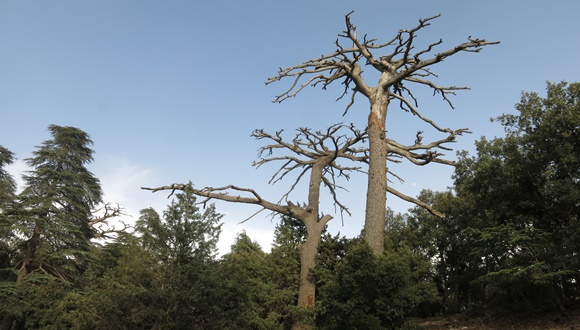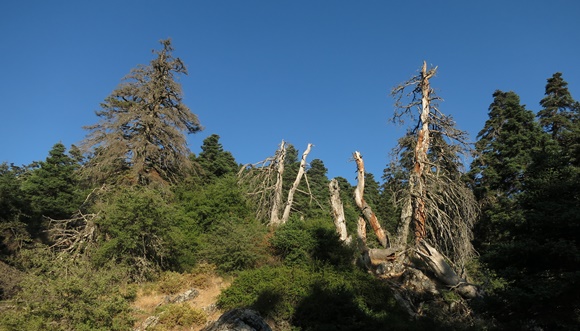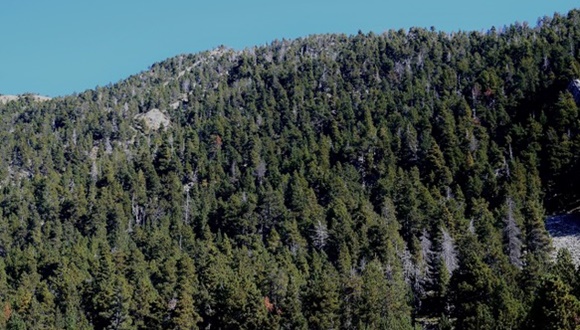A study shows how difficult it is for temperate forests to recover from severe drought
Climate change is making forests all over the world more vulnerable to drought, causing tree mortality episodes with serious ecological and social consequences. As yet, the traits of the vegetation replacing trees that have died as a result of drought are not known.
Scientific research conducted on 131 temperate forests (typical of non-tropical climates) across the planet has found that self-replacement of the dominant tree species following drought-related mortality occurred in only 21% of the sites studied. Furthermore, in a sign of how difficult it is for the original forest to recover, in 10% of the sites dead trees were replaced by non-woody vegetation very different from the previous forest and woodland cover.
The research, the main aim of which was to assess what species of trees and shrubs replace trees killed by drought, is explained in an article entitled entitled ‘Forest and woodland replacement patterns following drought-related mortality’, published today in the scientific journal Proceedings of the National Academy of Sciences (PNAS). The article’s lead author is Enric Batllori, a CREAF researcher and adjunct lecturer at the University of Barcelona’s Faculty of Biology. CREAF researchers Francisco Lloret and Sandra Saura Mas also contributed to the article, as part of a team of 37 experts from 28 universities and specialized centres in Algeria, Argentina, Australia, Belgium, Canada, Finland, Italy, Kenya, Norway, Scotland, Spain, Switzerland and the USA.

Not a prophecy of doom
The 131 forest and woodland sites analysed represent multiple biomes (a biome is a group of ecosystems that are typical of a geographical area and share climate conditions, flora and fauna) and were chosen because drought-related tree mortality had taken place there between one and 23 years before the study. “Long-term studies need to be carried out, but the indicators available to us today suggest that drought-induced mortality can sometimes lead to sudden changes in ecosystem traits, an example being when woodland is replaced by shrubland or grassland,” explains Enric Batllori. However, the researchers found that such changes are less pronounced under wetter post-drought conditions. “The current climate change is likely to result in drier conditions in many places, hindering the recovery of forests in which trees have died because of drought and other disturbances,” remarks Batllori.
This is not a prophecy of doom from the study’s lead author, however. He points out that the sites analysed did not experience total mortality but rather the deaths of individual trees on a varying scale. “Drought is affecting forests all over the world, but tree mortality on a massive scale is rare,” he emphasizes. “Furthermore, the vegetation that replaces dead trees is often better suited to the climate conditions we expect to see in the coming decades, which could boost ecosystem resilience in the long term.”

Drought and ecosystem reorganization
Drought-induced tree mortality could lead to major reorganization of forest ecosystems over the next few decades. “This phenomenon cannot be considered in isolation from other agents with an impact on forests, such as land management, fires and infestations,” says Francisco Lloret. “Forest mortality episodes are actually often a result of the combined effect of more than one of those agents.”
A forest’s post-drought ecological trajectory also depends on the characteristics of the species taking the place of those that were dominant previously. According to the article, species of vegetation that need little water generally grow more successfully following a drought, although in some forests the previously dominant species were replaced by others with similar water requirements. Post-drought species turnover is influenced by multiple factors, notably including drought intensity and duration, land use and past disturbances, and the species present in the affected area and their environmental preferences.

The article published in PNAS, one of the science arena’s most renowned journals, is partof BIOCLIM, a research project directed by Francisco Lloret, which involves using bioclimatic niche characterization to study how plants respond to drought. The article is also part of the TIPMED project, which is led by Enric Batllori and analyses fire-drought interaction and its influence on sudden ecosystem changes, with a particular focus in this case on how Pinus halepensis woodland can become scrub.
The CREAF-led article’s co-authors include specialists from several other Spanish institutions, namely the Pyrenean Institute of Ecology (Zaragoza), the Soria School of Engineering, Pablo de Olavide University of Sevilla, the University of Valladolid and the University of Córdoba. Among the non-Spanish universities and specialized centres whose researchers contributed to the article are the Canadian Forest Service, the University of Louvain (Belgium), the University of Stirling (Scotland), the University of Helsinki (Finland), the World Agroforestry Centre (Kenya), ETH Zürich and the Swiss Federal Institute for Forest, Snow and Landscape Research (both Switzerland), Murdoch University and the Queensland Herbarium (both Australia), and California State University, Humboldt State University, the University of Colorado Boulder and the University of California, Berkeley (all USA).







